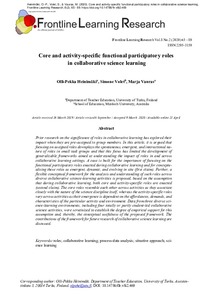Core and activity-specific functional participatory roles in collaborative science learning
Olli-Pekka Heinimäki; Simone Volet; Marja Vauras
https://urn.fi/URN:NBN:fi-fe2021042823946
Tiivistelmä
Prior research on the significance of roles in collaborative learning
has explored their impact when they are pre-assigned to group members.
In this article, it is argued that focusing on assigned roles downplays
the spontaneous, emergent, and interactional nature of roles in small
task groups and that this focus has limited the development of
generalizable frameworks aimed at understanding the impact of roles in
and across collaborative learning settings. A case is built for the
importance of focusing on the functional participatory roles enacted
during collaborative learning and for conceptualising these roles as
emergent, dynamic, and evolving in situ (first claim). Further, a
flexible conceptual framework for the analysis and understanding of such
roles across diverse collaborative science-learning activities is
proposed, based on the assumption that during collaborative learning,
both core and activity-specific roles are enacted (second claim). The
core roles resemble each other across activities as they associate
closely with the nature of the science discipline itself, whereas the
activity-specific roles vary across activities as their emergence is
dependent on the affordances, demands, and characteristics of the
particular activity and environment. Data from three diverse
science-learning environments, including four totally or partly
student-led collaborative science activities, were scrutinized to
establish the degree of empirical support for this assumption and,
thereby, the conceptual usefulness of the proposed framework. The
contributions of the framework for future research of collaborative
science learning are discussed.
Kokoelmat
- Rinnakkaistallenteet [27094]
